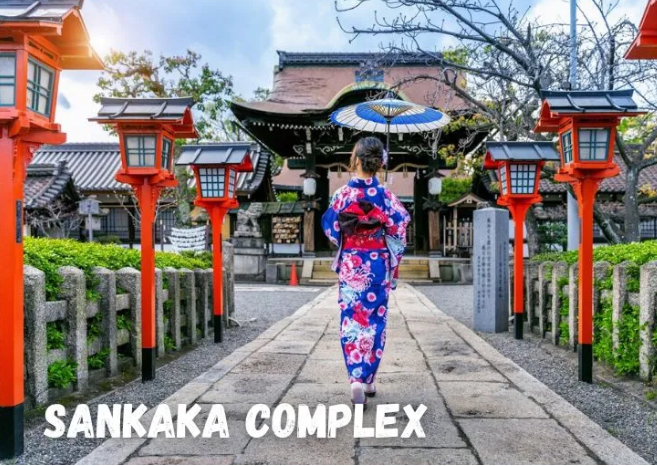The Sankaka Complex stands as a remarkable cultural and architectural phenomenon, intricately woven into the fabric of history and tradition. This site is more than just a physical structure; it embodies a rich tapestry of cultural, religious, and social elements that have evolved over centuries. Understanding the Sankaka Complex is crucial for anyone interested in the intersections of history, architecture, and culture, as it offers a unique glimpse into the lives and beliefs of the people who created and continue to revere it.
Historical Significance
The origins of the Sankaka Complex can be traced back to ancient times, making it a vital part of the historical narrative of the region. Its construction reflects the architectural styles and techniques of the era, showcasing the ingenuity and craftsmanship of the builders. Over the years, the complex has served various purposes, adapting to the changing needs and beliefs of the communities surrounding it.
The Sankaka Complex is often associated with significant cultural and religious events, acting as a hub for community gatherings, festivals, and rituals. These activities have contributed to its status as a revered site, preserving traditions that have been passed down through generations.
Architectural Features
The architecture of the Sankaka Complex is a testament to the artistic and technical skills of its creators. Characterized by intricate designs, symbolic motifs, and the use of locally sourced materials, the complex exemplifies the harmony between human creativity and the natural environment.
Key features often include:
- Symbolic Carvings: The walls of the complex are adorned with carvings that depict various aspects of life, spirituality, and nature. These artworks are not only aesthetically pleasing but also carry deep meanings and stories that reflect the community’s beliefs.
- Sacred Spaces: Within the complex, designated areas serve specific religious or cultural functions. These sacred spaces foster a sense of connection to the divine and provide a place for reflection and worship.
- Community Areas: The layout of the complex encourages communal interaction, with open spaces designed for gatherings and celebrations, emphasizing the importance of community in cultural practices.
Cultural Relevance
The Sankaka Complex holds immense cultural significance for the people who inhabit the region. It acts as a physical embodiment of their identity, history, and traditions. The rituals performed within its walls help to strengthen communal bonds, instilling a sense of pride and continuity among generations.
As a site of cultural heritage, the Sankaka Complex attracts visitors and scholars interested in exploring its historical and artistic value. It serves as a reminder of the importance of preserving such sites, not only for their beauty but also for the stories and lessons they carry.
Conclusion
The Sankaka Complex is more than just an architectural structure; it is a living testament to the cultural richness and historical depth of the community that reveres it. By understanding the complexities of this site, we gain valuable insights into the lives and beliefs of the people who created and continue to honor it. The Sankaka Complex stands as a powerful reminder of the intersection between history, architecture, and culture, inviting us to explore the narratives that shape our world. As we engage with such sites, we foster a deeper appreciation for the diverse traditions that enrich human experience.
FAQs about the Sankaka Complex
1. What is the Sankaka Complex?
The Sankaka Complex is a cultural and architectural phenomenon that embodies a rich tapestry of historical, religious, and social elements, reflecting the traditions and beliefs of the people who created it.
2. What is the historical significance of the Sankaka Complex?
The complex has its origins in ancient times and has served various purposes throughout history, acting as a hub for community gatherings, festivals, and rituals.
3. What are some architectural features of the Sankaka Complex?
Key features include intricate symbolic carvings, designated sacred spaces for worship, and community areas designed for gatherings, all showcasing the artistic and technical skills of its builders.
4. How does the Sankaka Complex reflect cultural identity?
The complex serves as a physical embodiment of the community’s identity and history, fostering a sense of pride and continuity among generations through rituals and traditions performed within its walls.
5. Is the Sankaka Complex a tourist attraction?
Yes, the Sankaka Complex attracts visitors and scholars interested in exploring its historical, cultural, and artistic value, emphasizing the importance of preserving such heritage sites.
6. What types of rituals are performed at the Sankaka Complex?
Rituals may include religious ceremonies, community celebrations, and cultural festivals that reinforce communal bonds and spiritual connections.
7. Why is the preservation of the Sankaka Complex important?
Preserving the Sankaka Complex is vital for maintaining cultural heritage, allowing future generations to connect with their history and understand the narratives that shape their identity.
8. How can one learn more about the Sankaka Complex?
Interested individuals can explore resources such as books, documentaries, or guided tours, and engage with local communities that celebrate the complex’s significance.
9. Are there any myths or stories associated with the Sankaka Complex?
Yes, the complex is often intertwined with local myths and stories that provide deeper meanings to its symbols and rituals, enriching its cultural context.
10. How does the Sankaka Complex influence modern architecture?
The architectural style and design principles of the Sankaka Complex may inspire contemporary architects and artists seeking to incorporate traditional elements and cultural significance into their work.
